May 29 through October 3, 2021
Crystal Bridges Museum of American Art
November 6, 2021 through January 31, 2022
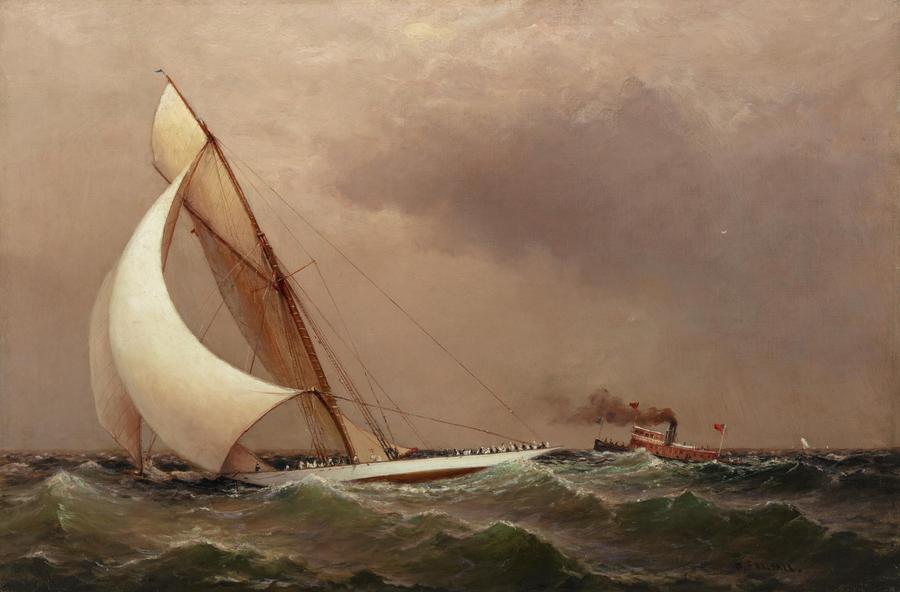
This May, the Peabody Essex Museum (PEM) debuts In American Waters, a painting exhibition that reframes and expands our understanding of American culture and environment by looking at the sea. For over 200 years, American artists have been inspired to capture the beauty, violence, poetry, and transformative power of the sea. The exhibition, on view at PEM in Salem, Massachusetts, from May 29 through October 3, 2021, features a diverse range of modern and historical artists, including Georgia O’Keeffe, Amy Sherald, Kay WalkingStick, Norman Rockwell, Hale Woodruff, Paul Cadmus, Thomas Hart Benton, Jacob Lawrence, Valerie Hegarty, Stuart Davis, and many others. In American Waters is co-organized by PEM and Crystal Bridges Museum of American Art.
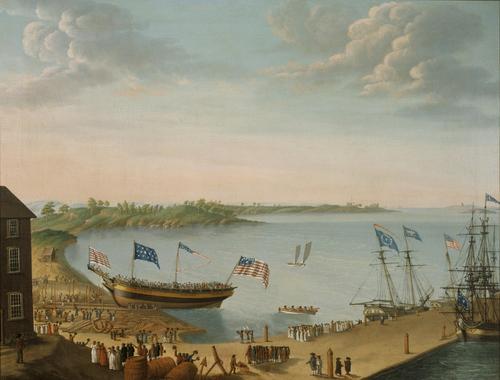
“As this exhibition vigorously asserts, marine painting is so much more than ship portraits. Through more than 90 works, we can trace changing attitudes about the symbolic and emotional resonance of the sea in America and see how contemporary perspectives are informed by marine traditions,” said Dan Finamore, PEM’s Associate Director — Exhibitions and the Russell W. Knight Curator of Maritime Art and History. “No matter where we live, the sea shapes all of our lives and continues to inspire some of the most exciting artists working today.”
Collaborative and interdisciplinary, In American Waters combines art history, marine history, and even neuroscience to encompass greater geographical breadth, a multiplicity of artists and artistic expressions, and a more inclusive vision for American marine painting and American art more broadly. To these ends, this exhibition is the first to grapple with how attitudes about the sea may manifest in works that are not traditional seascapes. Instead, the experience explores industry and political conflict, sailor culture, visions of the undersea world and abstraction, as well as legacies of the Middle Passage and immigrants’ points of entry.
Founded in 1799 by the East India Marine Society in Salem, Massachusetts, PEM developed one of the nation’s first and foremost maritime collections. Situated on one of New England’s most historic harbors, the museum has long stewarded, and celebrated the interplay of maritime history and global interconnectivity. Exhibition co-organizer, Crystal Bridges Museum of American Art, was founded in 2011 in the Ozarks. The region surrounding Bentonville, Arkansas, is known for its abundant waterways in the form of springs, creeks, lakes and rivers, most notably the White River that originates from the Boston Mountains of Northwest Arkansas and ultimately feeds into the mighty Mississippi River, which flows to the Gulf of Mexico.
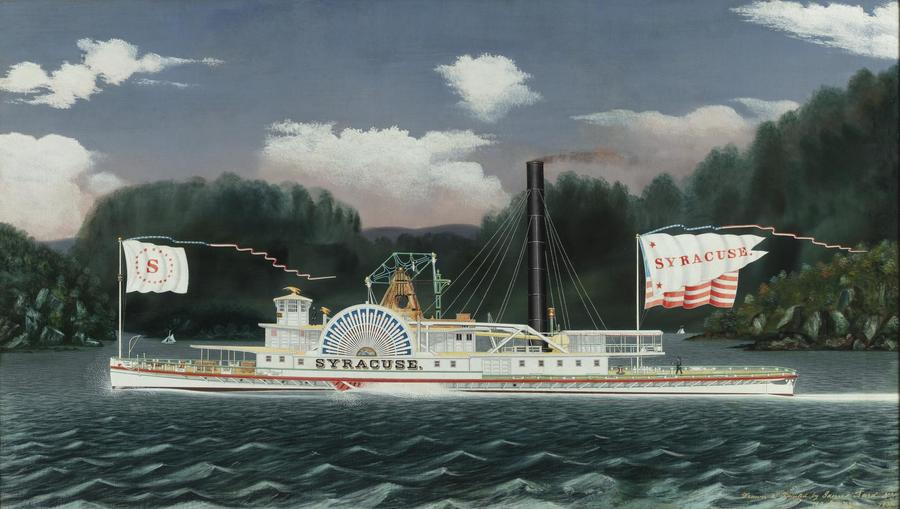
Even before marine art was produced in America, seascape paintings were included among items imported from Europe to decorate American homes in the latest style. Later, artists developed a distinctively American vision of the sea with an independent artistic identity.
The first artist in the United States to declare a specialty in marine subjects was Michele Felice Cornè. Cornè left Naples on Elias Hasket Derby’s ship, Mount Vernon, in 1799, bound for Salem, Massachusetts. Upon arrival, he became a kind of artist-in-residence to the local shipowners, painting vessel portraits and historical and allegorical images in oils and gouache. Cornè’s Ship America on the Grand Banks depicts the first of four ships so named by Salem’s Crowninshield family between Independence and the War of 1812. It was the last British war prize taken by colonial privateers during the American Revolution. Cornè portrays the renamed ship in the international waters of the Grand Banks fishing grounds off of Newfoundland amid French and British flagged vessels. The history of the ship and its prominent American flag, set within a competitive commercial setting, evokes pride in the new nation and its emerging international profile.
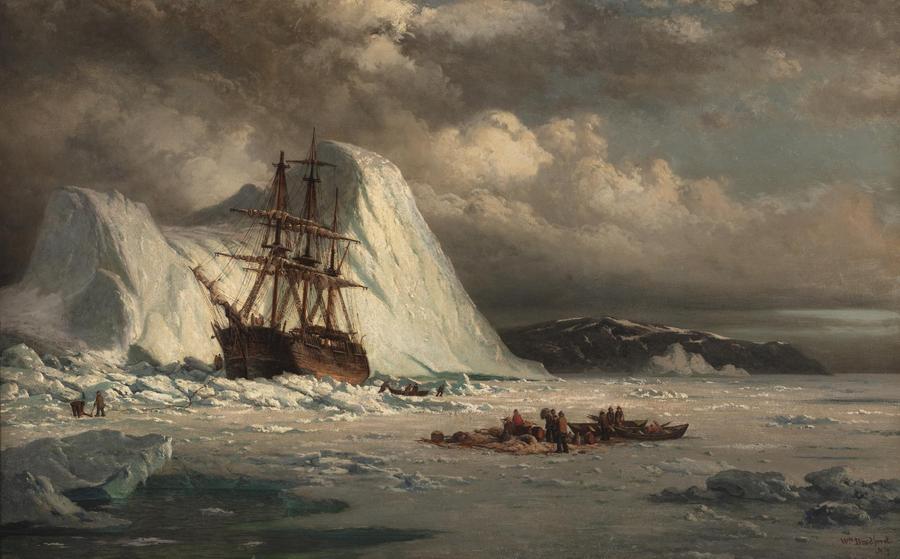
“To look anew at American marine painting, we studied and analyzed its colonial and Eurocentric origins and found that the genre is far more dynamic and broad than previously assumed,” said Austen Barron Bailly, Chief Curator at Crystal Bridges Museum of American Art. “When we think of marine painting we may think of high-seas realism and faithful portraits of ships but, as this exhibition attests, in practice we see broad-ranging expressions of American ambition, opportunity, and invention.”
Artists have long crafted narratives of deepwater activities that take place far beyond America’s shores, extending the image of the nation’s engagement with the world into mid-ocean and beyond. Captain of a whaling fleet, John Bertonccini was also an artist who was said to paint at every opportunity, even using the ship’s paint supplies when his own ran out. In the 1890s his fleet traveled into Arctic waters off the Yukon’s north coast in pursuit of their prey, allowing their ships to freeze into the ice so they could winter over rather than make the long journey home each year. In a new work to enter PEM's collection, the artist created a birds’-eye view of their winter grounds showing the crew playing soccer and baseball to pass the time.
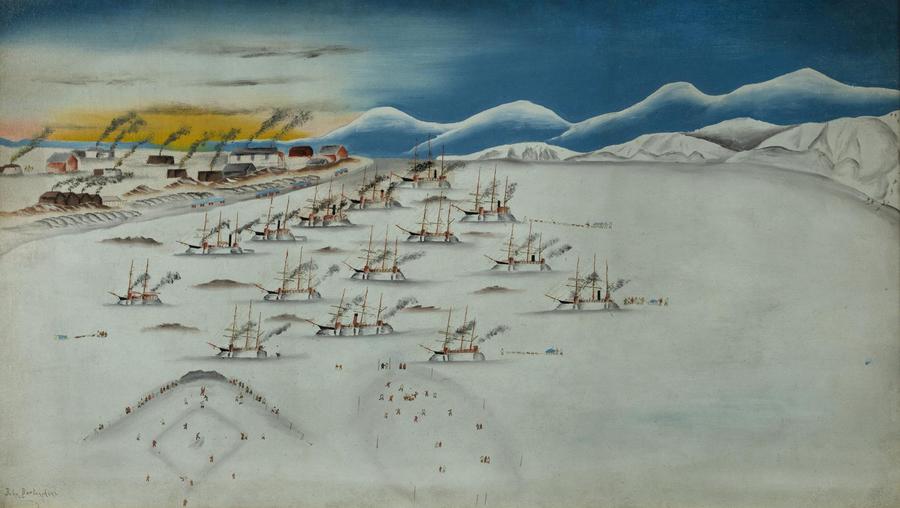
One of the few Native American women artists making marine paintings today, Kay WalkingStick (Cherokee Nation) expands American marine art traditions, evoking the seascapes of impressionist Childe Hassam and his response to Appledore Island located seven miles off the coast of New Hampshire, and modernists such as Georgia O’Keeffe, who was drawn to re-envision the experiences on nearby shores at Maine. WalkingStick’s 2020 painting, New Hampshire Coast, pictures a location along the shoreline near present day Portsmouth. The artist honors the unbroken connections between coastal waters and the Abenaki community of the Wabanaki Confederacy. Her own pattern of composite Native American basket motifs permeates the rocky shore, reminding us that these are Indigenous lands and waters.
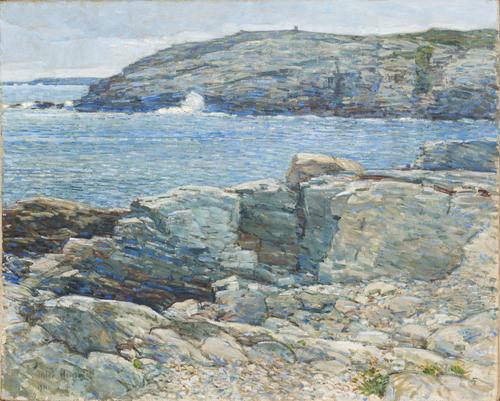
Amy Sherald continues the evolution of American marine painting with her 2019 painting, Precious jewels by the sea, a grand portrayal of four Black teenagers on a beach. Two boys stand tall with girls seated on their shoulders. They tower above a placid turquoise sea and the deep blue horizon. Their long shadows angle and cast over and beyond their red-and-white striped beach umbrella and straw picnic basket on the sand.
Mass appeal of the seascape and of the artist herself, who was the official portraitist of First Lady Michelle Obama, are central to this work. Sherald seeks to convey an expression of freedom. As the artist recently described, “I make these images of things that we normally do but we don’t get to see in spaces like museums. Like black people going to the beach. . . . It makes me think about my mother. She didn’t know how to swim, and she didn’t like going to the segregated black beaches because she wanted to go to the prettier white beaches. It makes me think about how much things have changed generationally. . . . So it’s really just about creating American narratives about American people — while critiquing it at the same time.”
Today the sea is on the minds of Americans, in part, because of sea-level rise and the impact of associated climate events on coastal communities and beyond. More than 90 percent of the world’s commerce travels by sea and it’s no coincidence that most major American cities are situated on waterways — whether around protected coastal harbors or inland at the confluence of major rivers.
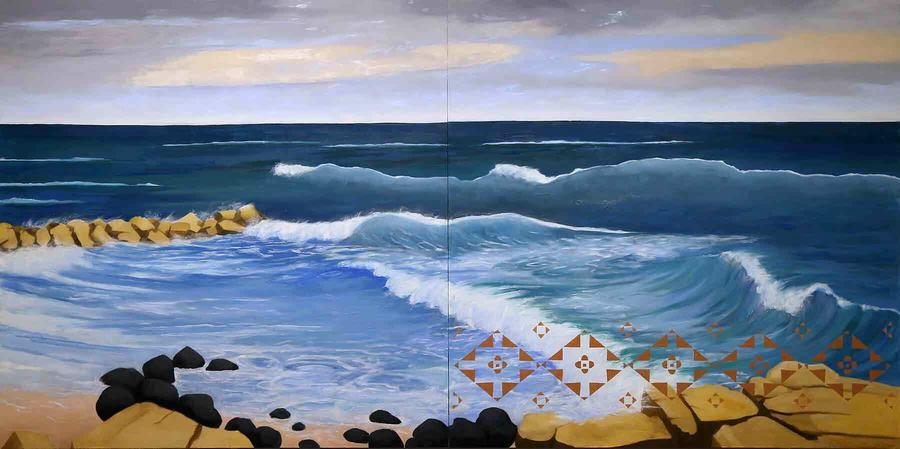
Artists have reflected Americans’ understanding of this significance and of the sea as a connector. Maritime paintings are a multisensory experience. For viewers in any part of the world, these works are particularly adept at evoking sonic qualities — the relentlessly repetitive crashing of surf upon a beach, sailors calling out to one another from a ship’s deck or high in the rigging. The noises of human activity such as the tolling of bells, laborers’ chanteys, and cannon fire can register the same emotional power as that of the open ocean with only the wind and waves. These sounds and sights, and the art they inspire, have the power to transport us.
The exhibition travels to Crystal Bridges Museum of American Art, November 6, 2021 through January 31, 2022.
Published by the Peabody Essex Museum, Crystal Bridges Museum of American Art, and the University of Arkansas Press, a related publication, In American Waters: The Sea in American Painting, highlights American art historical and cultural traditions associated with the sea, deepening our understanding of it as a symbol of American ambition, opportunity, and invention. Edited by Daniel Finamore, PEM’s Associate Director — Exhibitions and The Russell W. Knight Curator of Maritime Art and History, and Austen Barron Bailly, Chief Curator at Crystal Bridges Museum of American Art, this 240-page book includes more than 120 images, featuring fascinating historical paintings alongside works by major modern and contemporary artists. With contributions by Austen Barron Bailly, Mindy N. Besaw, Sarah N. Chasse, Daniel Finamore, and George H. Schwartz.
In American Waters highlights American art historical and cultural traditions associated with the sea, deepening our understanding of it as a symbol of American ambition, opportunity, and invention. The histories of American art have long privileged ways of imagining American culture that only tell a partial story and that overlook narratives of national and individual experience past and present. This ambitious volume reveals the sea as an expansive way to reflect on American culture and environment and to question what it means to be “in American waters.”
For more than 200 years, American painters have been inspired to capture the beauty, violence, poetry, and transformative power of the sea in American life. Their images of the sea have also expressed ambitions beyond America’s borders in aesthetically and conceptually distinctive ways. The eight essays included here offer a more inclusive way of thinking about American marine painting by reconsidering national symbols and narratives, origin stories, coastlines, horizons, and ports, and broadening the conversation to embrace perspectives on the Middle Passage, immigration, and Indigenous presence. Lavishly illustrated with more than 120 images, In American Waters features fascinating historical paintings alongside works by major modern and contemporary artists.
